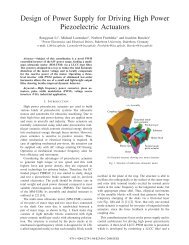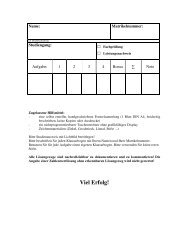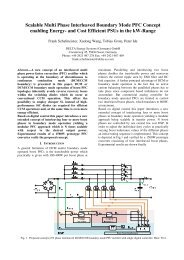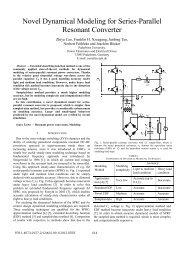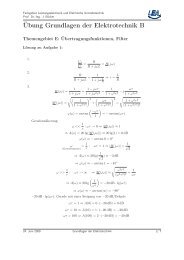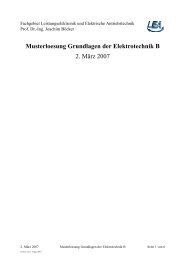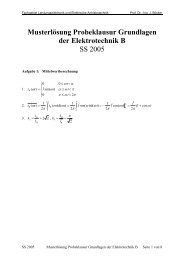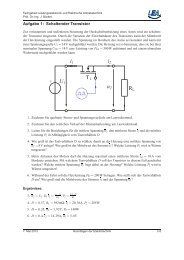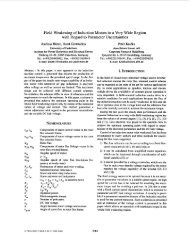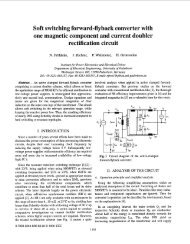Organization and Control of Autonomous Railway Convoys
Organization and Control of Autonomous Railway Convoys
Organization and Control of Autonomous Railway Convoys
Create successful ePaper yourself
Turn your PDF publications into a flip-book with our unique Google optimized e-Paper software.
AVEC ’08This distance also defines the inter-platoon distance. Incontrast, the relative braking distance d rel,n+1 is thedifference if the absolute braking distances <strong>of</strong> twoRailCabs <strong>and</strong> is defined asdrel,n 12n+1n+12nnv v+ = −(10)2a2aIt is safety critical to drive within the relativebraking distance. In order to avoid crashes, the vehiclesmust a priori agree upon the maneuvers. However, thiscannot be ensured in all cases. Therefore maneuvercontrol laws have been designed which minimizes riskswhile driving within distances <strong>of</strong> less than one meter.5.2 Maneuver <strong>Control</strong> LawsIn general three kinds <strong>of</strong> maneuvers in case <strong>of</strong>convoy mode can be distinguished: merging <strong>and</strong>splitting <strong>of</strong> convoys <strong>and</strong> driving in a platoon. Themaneuver control laws are based on the longitudinalcontrol described above. The reference generator adaptsthe reference values depending on the current situation<strong>and</strong> outputs a convoy state signal for switching betweenthe operating modes as described above.The control strategy is realized as a state modelwith the three main states NOCONVOY,MERGING/SPLITTING <strong>and</strong> PLATOON as shown in Fig. 10.In order to avoid permanent switching betweenstates, the conditions additional include a margin. Acomplete merging process is shown in Fig. 11. Whereasthe effective distance <strong>of</strong> 4 m has to be reduced by thevehicle length <strong>of</strong> 3.5 m.Fig. 11Convoy formation (complete process)PlatoonThe platoon phase is activated by the transitionfrom speed to position control. The criterion is aminimal distance d min which is needed for reducing thespeed difference between the two vehicles. Thus, thedesired distance is smoothly adjusted (see Fig. 12).Fig. 10State machine <strong>of</strong> the convoy control strategyMergingMerging <strong>of</strong> vehicles to a platoon is the most safetycritical operation because <strong>of</strong> unavoidable speeddifferences while driving within small distances.Therefore a control strategy is applied which limits thespeed during this process. Phase 1 <strong>of</strong> the mergingprocess begins with undershooting the absolute brakingdistance. Here the speed controller limits the speeddifference between follower <strong>and</strong> leader to 2m/s. Thespeed has to be reduced before the phase begins.The safety critical process starts with reaching therelative braking distance. In phase 2, the speeddifference is limited to 0.7m/s. A maximum speeddifference <strong>of</strong> 1 m/s when the time delay <strong>of</strong> activation<strong>and</strong> engagement <strong>of</strong> the hydraulic emergency brake(approximately 300 ms) is considered. This speeddifference is assumed to cause no remaining damages incase <strong>of</strong> a collision.Fig. 12control)Convoy formation (transition from speed to positionIn platoon mode, a fixed distance reference isapplied independent <strong>of</strong> the current vehicle speed. Thedesired distance is shortly undershot due to a brakingprocedure without propagation by the leader as shownin Fig. 13. This can be avoided with the a prioripropagation <strong>of</strong> changes <strong>of</strong> the operational pr<strong>of</strong>iles.Fig. 13 Reaction <strong>of</strong> follower after braking <strong>of</strong> the convoy leader innormal case



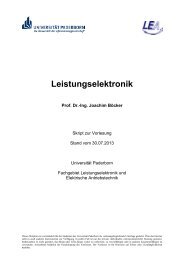

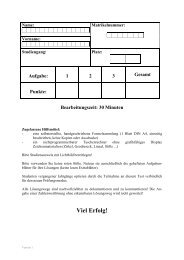
![[ ] Ï - Fachgebiet Leistungselektronik und Elektrische Antriebstechnik](https://img.yumpu.com/51151382/1/184x260/-i-fachgebiet-leistungselektronik-und-elektrische-antriebstechnik.jpg?quality=85)
